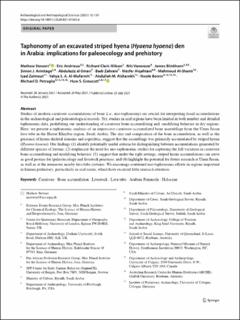| dc.contributor.author | Stewart, Mathew | |
| dc.contributor.author | Andrieux, Eric | |
| dc.contributor.author | Clark-Wilson, Richard | |
| dc.contributor.author | Vanwezer, Nils | |
| dc.contributor.author | Blinkhorn, James | |
| dc.contributor.author | Armitage, Simon James | |
| dc.contributor.author | Al-Omari, Abdulaziz | |
| dc.contributor.author | Zahrani, Badr | |
| dc.contributor.author | Alqahtani, Mesfer | |
| dc.contributor.author | Al-Shanti, Mahmoud | |
| dc.contributor.author | Zalmout, Iyad | |
| dc.contributor.author | Al-Mufarreh, Yahya S. A. | |
| dc.contributor.author | Alsharekh, Abdullah | |
| dc.contributor.author | Boivin, Nicole | |
| dc.contributor.author | Petraglia, Michael D. | |
| dc.contributor.author | Groucutt, Huw S. | |
| dc.date.accessioned | 2022-02-08T07:25:51Z | |
| dc.date.available | 2022-02-08T07:25:51Z | |
| dc.date.created | 2022-01-26T11:58:25Z | |
| dc.date.issued | 2021 | |
| dc.identifier.issn | 1866-9557 | |
| dc.identifier.uri | https://hdl.handle.net/11250/2977620 | |
| dc.description.abstract | Studies of modern carnivore accumulations of bone (i.e., neo-taphonomy) are crucial for interpreting fossil accumulations in the archaeological and paleontological records. Yet, studies in arid regions have been limited in both number and detailed taphonomic data, prohibiting our understanding of carnivore bone-accumulating and -modifying behavior in dry regions. Here, we present a taphonomic analysis of an impressive carnivore-accumulated bone assemblage from the Umm Jirsan lava tube in the Harrat Khaybar region, Saudi Arabia. The size and composition of the bone accumulation, as well as the presence of hyena skeletal remains and coprolites, suggest that the assemblage was primarily accumulated by striped hyena (Hyaena hyaena). Our findings (1) identify potentially useful criteria for distinguishing between accumulations generated by different species of hyenas; (2) emphasize the need for neo-taphonomic studies for capturing the full variation in carnivore bone-accumulating and modifying behavior; (3) suggest that under the right settings, striped hyena accumulations can serve as good proxies for (paleo)ecology and livestock practices; and (4) highlight the potential for future research at Umm Jirsan, as well as at the numerous nearby lava tube systems. We encourage continued neo-taphonomic efforts in regions important in human prehistory, particularly in arid zones, which have received little research attention. | en_US |
| dc.language.iso | eng | en_US |
| dc.publisher | Springer | en_US |
| dc.rights | Navngivelse 4.0 Internasjonal | * |
| dc.rights.uri | http://creativecommons.org/licenses/by/4.0/deed.no | * |
| dc.title | Taphonomy of an excavated striped hyena (Hyaena hyaena) den in Arabia: implications for paleoecology and prehistory | en_US |
| dc.type | Journal article | en_US |
| dc.type | Peer reviewed | en_US |
| dc.description.version | publishedVersion | en_US |
| dc.rights.holder | Copyright The Author(s) 2021 | en_US |
| dc.source.articlenumber | 139 | en_US |
| cristin.ispublished | true | |
| cristin.fulltext | original | |
| cristin.qualitycode | 1 | |
| dc.identifier.doi | 10.1007/s12520-021-01365-6 | |
| dc.identifier.cristin | 1990332 | |
| dc.source.journal | Archaeological and Anthropological Sciences | en_US |
| dc.relation.project | Norges forskningsråd: 262618 | en_US |
| dc.identifier.citation | Archaeological and Anthropological Sciences. 2021, 13, 139. | en_US |
| dc.source.volume | 13 | en_US |

